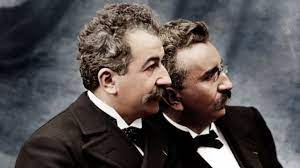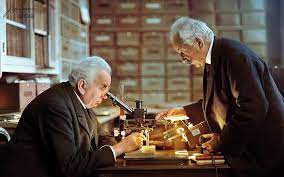
Famous for inventing the cinematograph and the autochrome, Auguste and Louis Lumière are among the most significant figures in film and photography history. With their first Cinématographe show in the basement of the Grand Café in the boulevard des Capucines in Paris on 28 December 1895, the Lumière brothers have been regarded as the inventors of cinema-the projection of moving photographic pictures on a screen for a paying audience.
However, they were probably not the first to do this: the Latham brothers in New York were screening boxing films to paying audiences from 20 May 1895, using their Eidoloscope projector. Nevertheless, the achievement of the Lumière brothers was considerable. Their Cinématographe was the first satisfactory apparatus for taking and projecting films, and its claw mechanism became the basis for most cine cameras.
The Lumière Brothers beginning
Auguste and Louis Lumière were born in Lyon, France, where their father, Antoine Lumière, had a photographic business. At the age of 17, Louis invented a highly sensitive photographic plate which the Lumière family began manufacturing. It was so successful commercially that the Lumières built a factory in the Monplaisir suburb of Lyon. By 1894, they were employing 300 people.
Late that year, Antoine saw an example of Edison’s peepshow Kinetoscope in Paris and encouraged his sons to devise an apparatus that would take and project moving pictures. Within a few months, they produced a successful prototype of the Cinématographe, which was not only a camera but a printer and projector as well. It was patented in France on 13 February 1895.
The cinematographe
Compared with other attempts at producing a movie camera, the Cinématographe was remarkably compact and, unlike the Edison Kinetograph, it did not rely on electrical power, which few premises had at that time. The Cinématographe could be taken anywhere, either to shoot film or to use as a projector-all that was required was a magic lantern lamphouse with a gas or limelight illuminant.
At the heart of the Cinématographe was the film transport mechanism, whereby two pins or ‘claws’ were inserted into sprocket holes at each side of the film, moved it down and were then retracted, leaving the film stationary for exposure. This intermittent movement was designed by Louis and based on the principle of the sewing machine mechanism.
The handle at the rear of the Cinématographe operated the rotating shutter and the take-up magazine as well as the film transport mechanism.
Making early films
The Lumière brothers’ first film (in fact, they made three versions) was shot outside their factory as the workers left at the end of the day. It was shown to the Société d’Encouragement à l’Industrie Nationale in Paris on 22 March 1895: this was probably the first public screening of moving pictures (the Lathams’ first public demonstration in New York took place on 21 April 1895). At the Paris meeting, Louis met the engineer Jules Carpentier, who undertook to refine and manufacture the Cinématographe for the Lumières.
Later that year, the Lumière brothers made a number of other films, all around a minute long, showing scenes such as Auguste and his wife feeding their baby; a train arriving at La Ciotât in the south of France; and possibly the first film comedy, L’arroseur arrosé, in which a mischievous boy tricks a gardener into being soaked with water and is chased and spanked. Another public demonstration of the Cinématographe was given to the French Photographic Congress held in Lyon in June 1895, when the delegates were particularly impressed at seeing film of themselves taken the previous day.
The public launch of cinematographe
Against his sons’ wishes (they thought it premature), Antoine Lumière decided to launch the Cinématographe publicly in Paris on 28 December 1895. The screening was organised by Antoine and Clément Maurice, with three members of the Lumière staff in charge of projection. The Lumière brothers and Carpentier were not there. The first show was given to an invited audience of journalists, theatre directors (including Georges Méliès) and friends. Thereafter, the public shows commenced.
Each show comprised ten films and lasted about 15 minutes. There were twenty shows a day, starting at 10.00 and ending at 01.30 the next morning, with breaks at 12.00-14.00 and 19.00-20.00. Admission was one franc.
There was little public interest at first-the few papers that reported on it criticised the name ‘Cinématographe’-but curious passers-by who ventured into the hall were astonished at what they saw and returned with their friends. News soon spread. On some days, queues extended a quarter of a mile, and the takings amounted to 2,500 francs (more than £42,000 in today’s money).
The cinematographe in Britain
The first public screening of the Cinématographe in Britain took place at the Malborough Hall of the Royal Polytechnic Institution in Regent Street, London on 21 February 1896. There had been a press show the previous day when, coincidentally, the British cinema pioneer Robert Paul had demonstrated his Theatrograph projector at Finsbury Technical College. In charge of the Polytechnic show was the Lumière brothers’ British agent, Felicien Trewey, a well-known showman and magician.
The opening performance attracted only 54 customers but, as in Paris, the Cinématographe’s popularity soon increased. Cinema quickly became part of music hall programmes, and Trewey started Cinématographe shows at the Empire Theatre in Leicester Square, London on 7 March 1896.
The cinematographe goes global
In the first years of the Lumière film operation, cameramen were sent all over the world to record scenes in locations such as Russia, Japan and the Holy Land. In America, the first Cinématographe show took place to great acclaim at Keith’s Union Square Theater, New York on 29 June 1896.
In November the Lumière brothers established their own agency in New York, selling equipment and films. This was very successful for a few months, but by April 1897 it began liquidating stock, and shortly afterwards transferred its business to the American agents Maguire & Baucus.
This was partly because the Lumière brothers had fallen foul of the American customs by importing apparatus and films illegally-their manager had to flee the country-but mainly because films sprocketed in the Edison format were becoming the industry standard.
The Lumière brothers began to issue copies of films in both their original and the Edison format, but the ubiquity of the latter signalled the obsolescence of the original Cinématographes. Before the end of 1897, the Cinématographe had largely been superseded by the Lumière Cinématographe Model B, a projection-only machine designed for film with Edison perforations.
The Lumière Brothers move away from cinema
Auguste and Louis continued to work on technical developments, and in 1900 devised a camera which took large-format 75mm films. By 1905, however, the Lumière brothers withdrew from the cinema business. They worked instead on inventing the first successful photographic colour process-the Lumière Autochrome-in 1907. Louis also worked on a process of stereoscopic cinematography. The two brothers lived long enough to be feted as pioneers of the cinema within their lifetimes. As Louis stated : … on December 28, 1895, was really born the expression: ‘I have been to a movie.’




No comments:
Post a Comment